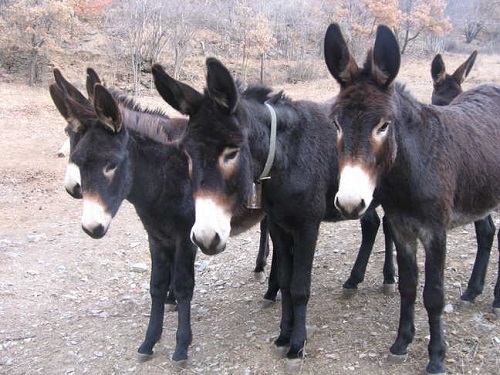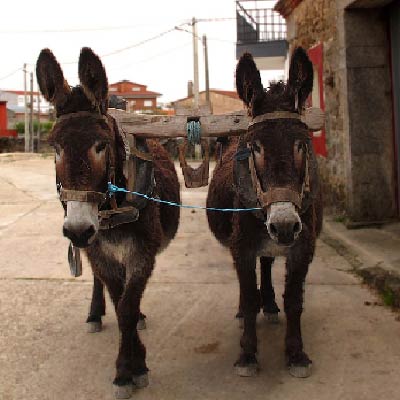Donkeys have their rightful share of the role in building up human civilization. They have been an integral part of human life before technological advancements and developments stripped them of their duties. And fulfilling those duties required them to be large and strong. Efficiency was more or less determined according to the size of the donkeys. Read about some of the large donkey breeds that have been in use since the oldest times and still manage to remain the largest among the hundreds of breeds in donkeys.
1. American Mammoth Jackstock
Also known as American Mammoth donkeys, the American Mammoth Jackstock is the world’s largest breed of donkeys. They can be easily distinguished from others due to their large size, big heads, and long ears, longer than most others. Mammoth donkeys measure from a minimum of 14 hands to the largest being 17 hands. They belong to large donkey breeds that were native to European lands and were brought to the United States during the 1700s. They were primarily used to produce draft and riding mules.

American Mammoth Jackstock are gentle and lively donkeys who love to socialize and be around the people they bond with. They make good pets and good riding animals who are easy to train and manage. Though mammoth jacks can be a handful at times, mammoth jennies are very easy to be around. This breed was characterized by its black color, which later changed into sorrel with changes in demand in the market. The historic black-colored mammoth donkeys are now endangered and in need of conservation.
2. Pega Donkeys
Pega donkeys, originating in Brazil, where they continue to be bred and live, are very intelligent and agile donkeys with long legs and ears. Their long ears are slightly curved inwards, which makes them stand unique. With its posture standing upright and tall, they look majestic. Their legs being longer than their body is also their distinguishing feature from other breeds of donkeys. They were used for producing gaited mules in the past due to their extraordinary gait. They are highly docile and display a dashing amount of dignity, with their lean posture and head always held upright.

These donkeys were on the verge of extinction but were saved on time due to the increased breeding rates. Even then, pure lines of Pega donkeys are still under the category of endangered.
3. Poitou Donkeys
Poitevian or Poitou donkeys, who hail from the French land, are also known as Baudet du Poitou. These are large donkeys that measure up to 15 hands high and adorn a distinct coat called cadanette. These are shaggy and ungroomed chords, which makes them stand unique from other donkey breeds. This coat sometimes even touches the ground when left ungroomed and often resembles dreadlocks.

Poitou jacks were used to produce Poitevin mules with Poitevin horses, which had high demands in the agricultural and other fields of work. Poitou donkeys are generally friendly and affectionate donkeys that have long heads and strong legs. This large breed of donkeys faced threats of extinction towards the end of the 19th century. With proper measures that followed, they restored their numbers to some extent, preventing the danger.
4. Andalusian Donkeys
The Andalusian donkey is a rare breed of donkey originating from Spain. These are said to be in existence for 3000 years and are considered the oldest among European breeds of donkeys. Andalusian donkeys are even believed to be the descendants of the Pharaoh donkeys of Egypt. They have their significant parts in history as well.

These donkeys are well-adapted to heat and semi-arid conditions and can survive with less water. They are calm and docile yet strong and sturdy. They were mainly used for work and as drought animals. In Andalusia, the alleged place of origin of these donkeys, they are known as domestic donkeys, which are highly used for agricultural works. Their disease-resisting capacities and ability to survive in adverse conditions make them a good pick for farmers. They usually appear in white and gray colors. These donkeys are critically endangered and their population is confined mostly to parts of Andalusia.
5. Catalan Donkey
Catalan donkeys are yet another breed of donkeys that are facing threats of extinction. These donkeys are said to be the most intelligent among their species and are strong and sturdy. They hail from the Catalan region, which previously belonged to Spain and Catalan donkeys are among the oldest breeds of donkeys in Spain. Their large and sturdy build, combined with other attractive factors, made them a good pick for producing strong mules. They are very hardworking and can carry heavy weights on them easily.

Catalan donkey’s influence is widely acknowledged in the formation of the American Mammoth Donkeys as well. In the modern days, these donkeys are mainly used for recreational tourism, as companion animals, and as riding animals for children. Catalan donkeys have recovered from serious threats of extinction since 2004, with extensive conservation and breeding programs.
6. Zamorano Leones
Hailing from the Zamora and Leon provinces of Spain, Zamorano Leones is a large donkey, standing to an average height of 145cm. These donkeys are one of the oldest donkeys in Spain, which is considered to be in existence since the 10th century. They were extensively transported to different parts of the world during the 18th century, making them actively take part in the production of many other breeds. Their influence in the creation of Poitou donkeys is most regarded.

Male Catalan donkeys were mainly used for agricultural work and for producing mules. These mules had huge demands for agricultural work then. Catalan donkeys are large, with a massive head and a spot of hair on it. Their distinctive shaggy coat distinguishes them from the others, which are mostly black or dark bay in color. They are also used for trekking, tourism, and leisure activities. Being an endangered breed, there are widespread measures in place trying to bring their numbers up from the verge of extinction.
7. Martina Franca Donkey
Martina Franca donkeys are native to Puglia in southern Italy and are the largest among Italian breeds. They were known for their capacity to create high-quality mules for agricultural work. This demand took them to many lands and continents of the world. The mules produced by them were even used in the First World War.

Martina Franca donkeys are friendly and sociable animals with a calm temperament. Besides their primary use of producing mules, these donkeys were used as beasts of burden and drought animals in the past. After the Second World War, the quality and performance of the mules produced by Martina Franca donkeys declined terribly, causing a huge plunge in demand. They were declared to be endangered in 2007, with their numbers only adding up to 400 in 2008. Measures for conservation are in place to revive the numbers.
Conclusion
These are some of the large donkey breeds that are renowned for their size and performance. And it is interesting to note that most of these breeds had significant roles in the history of civilization and in the making of many other breeds of donkeys that we see today. It is sad that most of them are also endangered and on the verge of extinction. Their hard work towards building up the community and living conditions of human beings cannot be overlooked.

![7 Large Donkey Breeds That You Should Know [With Pictures] large donkey breeds](https://donkeyonfarm.com/wp-content/uploads/2023/07/ass-1220250_1280_11zon.jpg)

![How Cold is Too Cold for a Donkey? [Plus Tips to Keep Them Warm] How-Cold-is-Too-Cold-for-a-Donkey](https://donkeyonfarm.com/wp-content/uploads/2022/09/How-Cold-is-Too-Cold-for-a-Donkey-270x180.jpg)
![Can Miniature Donkeys Be Therapy Animals? [Hint: They’re Different] can-miniature-donkeys-be-therapy-animals](https://donkeyonfarm.com/wp-content/uploads/2024/10/can-miniature-donkeys-be-therapy-animals-270x180.jpg)
![Do Donkeys Laugh? [Plus Why Do They Do It?] do-donkeys-laugh](https://donkeyonfarm.com/wp-content/uploads/2022/08/Why-do-donkeys-laugh-270x180.jpg)
![How to Get Rid of Flies on Your Donkey? [Plus Prevention Methods] How to Get Rid of Flies on your Donkey](https://donkeyonfarm.com/wp-content/uploads/2022/05/How-to-Get-Rid-of-Flies-on-your-Donkey-270x180.jpg)